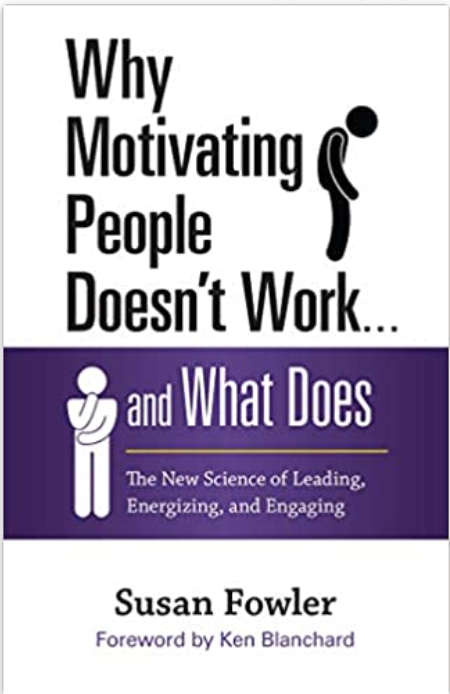Arlen’s Appreciative Book Inquiries explores
Why Motivating People Doesn’t Work… and What Does
“An important truth emerges when we explore the nature of motivation. People are always motivated. The question is not if, but why they are motivated.”
This quote captures the core message in the book Why Motivating People Doesn’t Work… and What Does by Susan Fowler; try to understand what drives people internally and you can get them to do what’s needed without constant carrot distribution or stick application. In fact, external rewards generally harm people’s ability to be effective by undermining the intrinsic motivations they already have. Fowler explores how to practically address this situation as a leader.
Traditional organizations often measure employee engagement, but this process is quite often too broad, generic and simplistic to make much impact at an individual level, which of course is what ultimately matters. Why Motivating People Doesn’t Work introduce a “Spectrum of Motivation” model with six “outlooks” (mental states) in which people might find themselves from moment to moment:
- Disinterested – “This is pointless.”
- External – “A ha, a chance for more power!”
- Imposed – “Well, if I must…”
- Aligned – “I can see how this could be useful.”
- Integrated – “This can make a huge difference!”
- Inherent – “Why not, could be fun!”
The latter three outlooks are the ones she suggests are optimal and will tend to lead to greater feelings of personal well-being, and in turn better performance. She tells a story of how weight loss programs with financial incentives often succeed at first… but fail spectacularly in the long run, as once people are left to rely on their internal drive rather than chasing a reward, they actually gain more weight than ever before.
Fowler suggests that three psychological needs are at the heart of understanding motivation: autonomy, relatedness and competence (ARC). Those of you who have read Daniel Pink’s Drive will recognize the similarity to the factors he promotes of autonomy, mastery and purpose. Relatedness is human connection, versus Pink’s promotion of a higher purpose, otherwise the ideas are similar. Some key points she makes:
- You must satisfy all three of these needs, not just some
- Once satisfied we want even more (e.g. there is no point of ultimate satiation)
- If all three needs are satisfied we will naturally reach a state of high performance
Much of the book describes how managers often behave in ways that run afoul of these needs:
- Pushing empowerment in the service of fleeting external rewards instead of lasting natural motivations. For instance: you do a good job as a waiter to earn tips, rather than simply feeling satisfied that you’re using your skill to help your patrons be happier… which of course would tend to lead to more tips anyway)
- Micromanaging to feel control yourself while removing all sense of competence and autonomy from your employees. They’ll feel that you’re self-interested and will do as little as possible to get by.
Self-regulation, or the ability to consciously control one’s own behavior, is the next topic explored. A key point that emerges here is that people will better self-regulate in environments where trust and safety are high, while they will binge on motivational “junk food” in ones where those factors are low, simply because they don’t believe anyone actually care about them. Fowler offers a few factors that need to be considered when trying to improve self-regulation:
- Mindfulness – The capability to observe a situation dispassionately before reacting.
- Values – Alignment of the organization’s mission with personal purpose.
- Purpose – A social significance to your work.
There’s a nice pithy quote here: “When employees thrive, leaders don’t need to drive.” Pay attention to what naturally motivates people and use the “MVPs” to align the way you and the organization support work, and good things will happen.
So how to achieve optimal motivation and stay there? Basically, find out where you are today, actively shift where you need to be and keep that cycle going. She suggests that you find a tough personal situation such as procrastinating about or avoiding something, consider what outlook you’re currently experiencing there, then think about how well you’re applying mindfulness, values and purpose to improve the situation. This will help to elucidate a path forward with higher quality motivation, but it does take conscious effort and self awareness.
One nuanced chapter explores how to help employees shift to higher motivational levels through “outlook conversations”, calling out three key no-no’s: Don’t problem solve, impose your values or expect a shift. Instead, prepare yourself mentally and logistically, and trust the process: identify that person’s motivations via root cause analysis techniques like the five whys, explore shifting them to a higher level, and reflect with her on the experience.
She uses a few very common aphorisms to show how many managers and employees alike make assumptions that lead to disengaged employees and soulless businesses. Some of the well-worn orthodoxies that she explicitly counters are:
- It’s not personal, it’s just ______
- Leaders are in a position of ______
- If you can’t measure it, it ______
I won’t spoil the surprise of how she addresses these, but suffice it to say that I think she does a strong job of it, and my experiences correlate well with her examples. There are many stories throughout the book about situations that most managers will likely find relatable, and the deep and flexible way in which they’re explored does a good job of illustrating the process that she promotes. She also provides ample references from well-conducted experiments, something that I appreciate in a world riven with evidence-free advice.
I found this book well-written, personally engaging and useful. As a leader I often struggle with motivating others because it’s hard enough to motivate myself, but one key lesson here is that addressing one problem can help to address the other; by actively practicing motivational skills internally you’ll get good at applying them to help your employees and organization deal with tough situations. Recommended.
Arlen Bankston is a Certified Scrum Trainer and CoFounder of LitheSpeed.
Discuss further and recommend the next read – connect with our Agile coaches at our Agile Coaching Circles.


